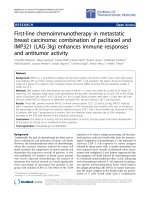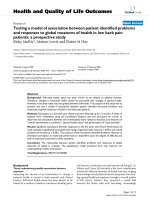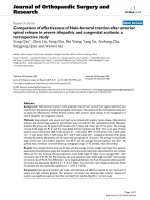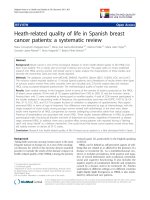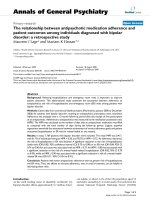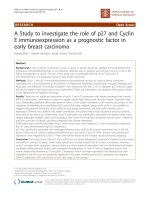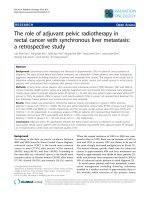Long-term use of metformin and the molecular subtype in invasive breast carcinoma patients – a retrospective study of clinical and tumor characteristics
Bạn đang xem bản rút gọn của tài liệu. Xem và tải ngay bản đầy đủ của tài liệu tại đây (257.79 KB, 7 trang )
Besic et al. BMC Cancer 2014, 14:298
/>
RESEARCH ARTICLE
Open Access
Long-term use of metformin and the molecular
subtype in invasive breast carcinoma patients – a
retrospective study of clinical and tumor
characteristics
Nikola Besic1*, Nika Satej2, Ivica Ratosa1, Andreja Gojkovic Horvat1, Tanja Marinko1, Barbara Gazic1 and Rok Petric1
Abstract
Background: Metformin may exhibit inhibitory effects on cancer cells by inhibiting mTOR signaling pathway. The
aim of our retrospective study was to examine if patients with breast carcinoma (BC) and diabetes mellitus (DM)
receiving metformin have a lower stage of carcinoma in comparison to patients not receiving metformin, and if the
use of metformin correlates with the molecular subtype of BC.
Methods: A chart review of 253 patients with invasive BC and DM (128 on metformin and 125 not on metformin)
was performed. Control group consisted of 320 consecutive patients with invasive BC without DM. BC subtypes were
classified by immunohistochemical surrogates as luminal A (estrogen receptor [ER] + and/or progesterone receptor
[PR]+, HER-2-), luminal B (ER + and/or PR+, HER-2+), HER-2 (ER-, PR-, HER-2+), triple-negative/basal (ER-, PR-, HER-2-).
Results: Patients on metformin had a lower proportion of T3 or T4 tumors than patients who were not receiving
metformin (16% vs. 26%; p = 0.035). No statistical difference was found between the two study groups in N stage.
Patients with DM on metformin, with DM not on metformin and the control group had different molecular
subtypes of BC (p = 0.01): the luminal A subtype was found in 78%, 83% and 71%, the luminal B in 12.6%, 9% and
11%, HER-2 in 0.8%, 1.6% and 8%, and the triple-negative/basal-like subtype in 8.6%, 6.4% and 10%, respectively.
Conclusion: Our data indicate that long-term use of metformin use correlates with molecular subtype of BC in
diabetics on metformin in comparison to diabetics not on metformin and patients without DM. However, most
likely, different distribution of the molecular subtypes of BC in these three groups of patients was caused by other
risk factors for breast carcinoma, such as age of patients or obesity.
Keywords: Breast carcinoma, Diabetes mellitus, Prognosis, Metformin
Background
Epidemiological studies show that patients with diabetes
mellitus (DM) have an increased risk of breast carcinoma and that metformin treatment is associated with a
reduction in cancer risk [1,2]. It is known that antidiabetic drugs may have an impact on breast carcinoma
[3,4]. Patients with type 2 diabetes exposed to sulphonylurea or exogenous insulin had a significantly increased
risk of cancer-related mortality compared with patients
exposed to metformin [5].
* Correspondence:
1
Institute of Oncology Ljubljana, Zaloska 2, 1000 Ljubljana, Slovenia
Full list of author information is available at the end of the article
Jiralensung et al. [4] reported that diabetic patients
with breast cancer receiving metformin and neoadjuvant
chemotherapy have a higher pathological complete response rate than diabetics not receiving metformin. Although metformin treatment did not influence the overall
survival in this retrospective study, these results have led to
a huge interest in metformin as an anti-cancer agent [6].
Metformin may exhibit inhibitory effects on cancer cells by
inhibiting the mTOR signaling pathway. Metformin has
anti-proliferative effects in primary breast carcinoma (BC)
tumors [7]. Metformin alone inhibits cell proliferation
and induces apoptosis in different breast cancer cell lines
(ERα-positive, HER2-positive, and triple-negative) [8].
© 2014 Besic et al.; licensee BioMed Central Ltd. This is an Open Access article distributed under the terms of the Creative
Commons Attribution License ( which permits unrestricted use, distribution, and
reproduction in any medium, provided the original work is properly credited. The Creative Commons Public Domain
Dedication waiver ( applies to the data made available in this article,
unless otherwise stated.
Besic et al. BMC Cancer 2014, 14:298
/>
Furthermore, metformin sensitizes breast cancer cells to
the cytotoxic effect of chemotherapeutic drugs in vitro
[8]. In BC patients without diabetes mellitus (DM), the
gene set analysis revealed a reduced expression of p53,
BRCA1 and cell cycle pathways after two-week of treatment with metformin [9]. Therefore, it is possible that
metformin has also an impact on tumor extension and
progression in breast carcinoma (BC) patients. The aim
of our retrospective study was to examine if the patients
with BC and DM receiving metformin have a lower stage
of carcinoma when compared to patients not receiving
metformin. Another aim was to find out whether longterm use of metformin correlates with the molecular subtype of BC.
Methods
Altogether, 253 (median age 67; range 38–93 years) patients with DM were surgically treated for invasive
breast carcinoma at a single comprehensive tertiary
cancer center from 2005 to 2011. In the same department, around 800 BC surgical procedures are performed annually. Referral to our center has not
changed over these years. In order to avoid selection
bias, all 320 consecutive patients with BC without DM
(median age 60, range 28–86 y.), who were surgically
treated in our tertiary cancer comprehensive center in
the first half of 2006 were included in our control
group. A chart review of all 573 patients was 80
performed.
The following data on clinical and histopathological
characteristics were collected: patients’ age, body
mass index (BMI), TNM tumor stage, number of
metastatic lymph nodes, presence of estrogen and
progesterone receptors and HER-2 expression. Tumor
stage, presence of regional metastases, distant metastases and residual tumor after surgery were assessed
by TNM clinical classification system according to
the UICC criteria from 2009 [10]. BMI was calculated
as weight/height 2 (kg/m2). Co-morbidity was assessed
by the American Society of Anesthesiologists (ASA
score) [11].
In this study, routine pathology reports of surgical
specimens were used. Histological slides were examined
by six pathologists experienced in breast pathology. The
histological type of each tumor was defined according to
the WHO classification system. Tumor grade was defined according to the modified Black’s nuclear grading
system. Sentinel lymph nodes were examined by imprint
cytology and immunohistochemistry in paraffin sections
[12]. If sentinel nodes turned out to be tumor-free, no
further axillary surgery was recommended. In case of
metastasis in sentinel lymph nodes detected by imprint
cytological investigation, the patient underwent axillary
dissection during the same surgical procedure. In case of
Page 2 of 7
malignant involvement only in the paraffin section, axillary dissection was performed. For the purposes of this
study, estrogen receptors (ER) and progesterone receptors (PR) were considered positive if 10% or more tumor
cells showed positive staining. The status of HER-2 receptors was determined by immunohistochemistry and
fluorescence in situ hybridization. HER-2–positive tumors were defined as 3+ receptor over-expression on
IHC staining and/or gene amplification found on fluorescence in situ hybridization testing. Unfortunately, in
the majority of our patients the expression of Ki-67 was
not assessed, so we were not able to classify our patients
according to the new St. Gallen Consensus 2013 [13]
which defined the surrogate intrinsic subtypes of breast
cancer according to ER, PR, HER-2 status and also
Ki-67. In our study molecular subtypes of BC were
classified by immunohistochemical surrogates as luminal A (ER + and/or PR+, HER-2-), luminal B (ER + and/
or PR+, HER-2+), HER-2 (ER-, PR-, HER-2+), triplenegative/basal (ER-, PR-, HER-2-) as was done in the study
of Wiechmann et al. from the Memorial Sloan-Kettering
Cancer Center [14].
Factors recorded for this study included surgical
breast cancer treatment (breast-conserving surgery
vs. mastectomy), axillary surgery (sentinel lymph
node biopsy vs. axillary dissection), adjuvant chemotherapy, hormonal treatment and/or treatment with
trastuzumab.
Our study was reviewed and approved by the Institutional Review Board of the Institute of Oncology
Ljubljana and was performed in accordance with the
ethical standards laid down in an appropriate version of
the 1964 Declaration of Helsinki. Our study was conducted with the understanding and the consent of the
subjects. All our patients are asked during the first admission to our institute or during a follow-up visit to give
a consent for study of her/his chart and/or bioptic material for scientific purposes. Since the Institutional Review
Board of the Institute of Oncology Ljubljana approved
this specific study, our patients were not asked to give a
written consent on this specific study.
Statistical analysis
Statistical analysis of these factors (comparison of metformin group vs. no metformin group and comparison
of metformin group vs. no metformin group vs. control
group) was performed by contingence tables, ANOVA
for normally distributed numerical variables and nonparametric tests for non-normally distributed numerical
variables. Multivariate logistic regression was done in
order to find out which factors were predictive factors
for presence of regional metastases. A p-value of 0.05 or
less was considered statistically significant. For statistical
analysis, SPSS 16.0 for Windows was used.
Besic et al. BMC Cancer 2014, 14:298
/>
Results
Median age of patients with diabetes, BMI, tumor size
and number of metastatic lymph nodes was 67 years,
29.7 kg/cm2, 2.1 cm and 1, respectively. Characteristics
of (1) patients treated with metformin, (2) patients not
treated with metformin and (3) control group of patients
are presented in Table 1. The tumor-specific therapy and
outcome of all three groups of patients are presented in
Table 2.
Patients with DM were older than patients without
DM (p < 0.001), had a larger median BMI (29.7 vs. 25.8;
p = 0.0001), a larger median tumor diameter (2.1 vs.
1.8 cm; p = 0.004) and a higher tumor stage (T1/T2: 79%
vs. 87%; T3/T4: 21% vs. 13%; p = 0.01). Patients with
DM, as compared to patients without DM, showed no
statistical difference in the rate of regional (50% vs. 47%)
or distant metastases (3.6% vs. 2%) or in the median
number of metastatic lymph nodes (1 vs. 0), respectively.
Tumors in patients with DM were more often positive
for ER (90% vs. 81%) and PR (74% vs. 65%) than tumors
in patients without DM (p < 0.03). So, patients with DM
were more often treated with hormones and less often
with chemotherapy than patients without DM (p < 0.01).
Tumors were HER-2 positive in patients with and without DM in 12% and 19% (p = 0.03), respectively. Patients
with DM and the control group had different molecular
subtypes of BC (p = 0.01): the luminal A subtype was
found in 80% and 71%, the luminal B in 11% and 11%,
HER-2 in 1% and 8%, and the triple-negative/basal-like
subtype in 7% and 10%, respectively.
DM type 1 and DM type 2 were present in 40 and 213
cases, respectively. Altogether, 128 patients (median age
65; range 39–88 years) were on metformin, while 125
(median age 69; range 37–93 years) were not. Compared
to patients not receiving metformin, a larger proportion
of patients on metformin were younger than 71 years
(p = 0.003) and had a smaller T stage (T1: 49% vs. 46%;
T2: 35% vs. 28%; T3: 7% vs. 5%; T4: 9% vs. 21%, p = 0.03).
Patients on metformin had a lower proportion of T3 or T4
tumors than patients who were not receiving metformin
(16% vs. 26%; p = 0.035). No statistical difference was found
between the two study groups in N stage (p = 0.90). Median tumor size (2.05 cm vs. 2.1 cm; p = 0.46), tumor grade,
median number of metastatic lymph nodes (1 vs. 0.5;
p = 0.79), ER status (p = 0.97), PR status (p = 0.28), HER-2
status (p = 0.46) or molecular subtypes of BC (p = 0.60) did
not show any statistical difference between the two study
groups (Table 1). There was a trend for a higher rate of
ductal type of BC in patients with DM on metformin in
comparison to those not receiving metformin (90% vs.
82%, p = 0.086). There was no statistical difference in the
rate of lymphadenectomy or treatment with radiotherapy,
chemotherapy, hormonal therapy or trastuzumab between
the two groups of patients with DM. Patients with DM on
Page 3 of 7
metformin, those with DM not on metformin and the
control group had different molecular subtypes of BC
(p = 0.01): the luminal A subtype was found in 78%, 83%
and 71%, the luminal B in 12.6%, 9% and 11%, HER-2 in
0.8%, 1.6% and 8%, and the triple-negative/basal-like subtype in 8.6%, 6.4% and 10%, respectively.
Age, BMI, hormone receptor status, HER2 status,
tumor grade and molecular subtype were included in the
multivariate analysis in order to find out which were
independent predictive factors for the presence of regional metastases. Only a tumor differentiation was independent predictive factor for the presence of regional
metastases.
Discussion
The aim of our study was to find out if the patients with
BC and DM receiving metformin have a lower stage of
carcinoma when compared to patients not receiving
metformin. Our hypothesis was that the use of metformin slows down the progression of breast carcinoma in
comparison to other types of anti-diabetic drugs. We
found that patients on metformin had a lower proportion of T3 or T4 tumors than patients who were not
receiving metformin (16% vs. 26%; p = 0.035). However,
there was no significant difference in tumor diameter,
tumor grade or median number of metastatic lymph
nodes between the two study groups. Our patients using
metformin had the same rate of ER and PR as those not
receiving metformin. Thus, our data do not confirm the
findings of Berstein et al. [15] who, in 90 postmenopausal BC patients with DM, observed a higher rate of
positive progesterone receptors in patients on metformin when compared to those on sulphonylurea or insulin
(73% vs. 37%).
Aksoy S et al. investigated the demographic and
clinico-pathological characteristics of metformin users in
comparison with patients without diabetes matched with
the same age at the time of breast cancer diagnosis [16].
Patients who received insulin treatment were excluded.
Metformin users had lower incidence of grade 3 tumors
and lower incidence of triple-negative disease [16]. On
the other hand, hormone receptor positivity was significantly higher in metformin users compared to nonusers;
thus, hormonal treatment history was higher in metformin users [16]. Our patients using metformin did not
have lower incidence of grade 3 tumors or lower incidence of triple-negative disease in comparison to diabetics not on metformin and/or patients without DM.
But hormone receptor positivity was higher in our metformin users, so more metformin users had hormonal
treatment in comparison to nonusers or patients without
DM.
There is an emerging body of evidence supporting
the hypothesis that short-term use of metformin has
Besic et al. BMC Cancer 2014, 14:298
/>
Page 4 of 7
Table 1 Tumor and demographic characteristics of 253 patients with breast carcinoma and diabetes (128 on and 125
not on metformin) and 320 patients with breast carcinoma without diabetes
Factor
Sub-group
Median age (years)
Patients with breast
Patients with breast
Patients with breast
carcinoma and diabetes carcinoma and diabetes carcinoma without
without metformin
on metformin
diabetes
P1
P2
69
65
60
29.35
30.30
25.80
0.18
0.0001
2
2
2
0.78
0.0001
Median tumor size (cm)
2.1
2.05
1.8
0.46
0.014
Median number of metastatic
lymph nodes
0.5
1
0
0.79
0.78
72
96
248
2
Median BMI (kg/m )
Median ASA score
Age (years)
70 or less
71 or more
53
32
72
BMI (kg/m2)
Less than 30
70
58
258
(N = 562)
30 or more
51
63
62
ASA score (N = 480)
1
3
0
103
2
77
80
119
3
38
38
22
No
105
128
-
Yes
20
0
-
No
78
69
320
Yes
47
59
0
pT1
57
63
192
pT2
35
45
87
Diet only (N = 253)
Therapy with sulphonylurea
pT tumour stage
T3 or T4 stage
N stage (N = 572)
pT3
6
9
20
pT4
27
11
21
pT1 or pT2
93
108
279
pT3 or pT4
33
20
41
pN0
63
65
173
pN1 or pN2
62
63
146
63
63
173
32
39
80
Number of metastatic lymph nodes 0
(N = 572)
1–3
M stage
4 or more
30
26
66
M0
120
124
313
M1
Type of invasive carcinoma
Molecular subtype of carcinoma
(N = 569)
Tumor differentiation (N = 566)
ER status (10% or more) (N = 570)
PR status (10% or more)
5
4
7
103
115
274
Lobular or other
22
13
46
Luminal A
104
99
226
Luminal B
11
16
35
HER-2
2
1
25
Ductal
Triple negative
8
11
31
Well or moderate
69
73
177
Poor
56
75
136
Positive
113
115
258
Negative
12
12
60
Positive
96
90
207
Negative
29
37
111
0.034 0.0001
0.003 0.0001
0.122 0.0001
0.21
0.0001
-
-
-
-
0.031 0.0001
0.035
0.003
0.90
0.78
0.68
0.75
0.75
0.55
0.086
0.23
0.60
0.01
0.67
0.89
0.97
0.008
0.28
0.049
Besic et al. BMC Cancer 2014, 14:298
/>
Page 5 of 7
Table 1 Tumor and demographic characteristics of 253 patients with breast carcinoma and diabetes (128 on and 125
not on metformin) and 320 patients with breast carcinoma without diabetes (Continued)
ER status (1% or more) (N = 570)
PR status (1% or more)
HER-2 (N = 569)
Triple-negative tumor (N = 569)
Positive
114
116
263
Negative
11
12
57
Positive
106
99
218
Negative
19
29
102
Negative
112
110
257
Positive
13
17
60
No
117
116
286
Yes
8
11
31
0.87
0.011
0.13
0.001
0.46
0.06
0.49
0.53
P1: p-value (DM not on metformin vs. DM on metformin).
P2: p-value (DM not on metformin vs. DM on metformin vs. controls).
ER: estrogen receptor status.
PR: progesteron receptor.
an impact on BC tumor cells in newly diagnosed, untreated, non-diabetic early-stage breast cancer patients
[2,7,9,17]. Ki67 staining in invasive tumor tissue decreased in surgical specimen in patients who received
metformin after diagnostic core biopsy [7]. A similar
study was conducted by Hadad et al. [9] who observed a
reduced expression of p53, BRCA1 and cell cycle pathways after 2-week treatment with metformin in BC patients without DM [9]. However, we were not interested
in short-term action of metformin use. The aim of our
study was to find out if long-term use of metformin correlates with the molecular subtypes of BC. We found that
patients with DM on metformin, those with DM not on
metformin and the control group of patients without DM
had different molecular subtypes of BC: the luminal A
subtype was found in 78%, 83% and 71%, the luminal B
in 12.6%, 9% and 11%, HER-2 in 0.8%, 1.6% and 8%, and
the triple-negative/basal-like subtype in 8.6%, 6.4% and
10%, respectively. However, the comparison of the molecular subtypes in a group of patients with DM on metformin and in those not receiving metformin did not
show statistically different distribution. Thus, our data do
not support the hypothesis that long-term use of metformin in diabetics correlates with the distribution of the
molecular subtype of BC. Most likely, different distribution of the molecular subtypes of BC in these three
groups of patients was caused by other risk factors for
breast carcinoma, such as age of patients or obesity.
Xiao et al. [18], studied a clinical-pathological characteristic in Luminal A subtype of breast cancer, Luminal B
Table 2 Carcinoma-related treatment in 253 patients with breast carcinoma and diabetes (128 receiving and 125 not
receiving metformin) and 320 patients with breast carcinoma without diabetes
Factor
Sub-group
Breast surgical procedure
Axillary surgical procedure
Adjuvant chemotherapy
Patients with breast
carcinoma and diabetes
without metformin (N = 125)
Patients with breast
carcinoma and diabetes
on metformin (N = 128)
Patients with breast
carcinoma without
diabetes (N = 320)
P1
P2
Quadrantectomy or
lumpectomy
48
59
157
0.21
0.13
Mastectomy
77
69
163
Sentinel node biopsy
54
61
147
0.43
0.73
Lymphadenectomy
71
67
173
No
94
87
196
0.20
0.02
Yes
31
41
124
0.89
0.0001
0.17
0.22
0.23
0.44
Adjuvant hormone
therapy
No
14
15
76
Yes
111
113
244
Adjuvant trastuzumab
No
118
115
285
Yes
7
13
35
No
60
52
135
Yes
65
76
185
Adjuvant radiotherapy
P1: p-value (DM not on metformin vs. DM on metformin).
P2: p-value (DM not on metformin vs. DM on metformin vs. controls).
Besic et al. BMC Cancer 2014, 14:298
/>
(high Ki67) and Luminal B (Her-2+) subtype. They found
out that luminal subtype was present in 68% of patients
with BC and 10% of them had DM. They reported data
about 1,384 Luminal A-subtype breast cancer patients, including 201 patients with diabetes; 3, 393 Luminal B (high
Ki67)-subtype breast cancer patients, including 341 patients with diabetes; and 1,008 Luminal B (Her-2+)-subtype
breast cancer patients, including 138 patients with diabetes
[18]. A Cox multivariate regression analysis showed that
among Luminal A and Luminal B (Her-2+) subtype patients, the metformin group had a better prognosis than
did the non-metformin group, but there was no difference in prognosis between the metformin group and
the non-diabetic group. For the Luminal B (high Ki67)
subtype, the metformin group had a better prognosis
than both the non-metformin group and the non-diabetic
group [18].
Bayractar et al. [19] studied whether the use of metformin during adjuvant chemotherapy has an impact on
the survival of patients with triple-negative BC. The
study cohort was comprised of 63 diabetic patients receiving treatment with metformin, 67 diabetic patients
not receiving metformin, and 1318 non-diabetic patients
[19]. They found that metformin use during adjuvant
chemotherapy did not affect the survival outcomes in
diabetic patients with triple-negative breast cancer [19].
In our diabetic patients, as compared to those without
DM, the rate of triple-negative BC was not significantly
different. Metformin use in our diabetic patients was not
correlated with the presence of triple-negative BC. The
rate of triple-negative BC in our patients with DM on
metformin, those not on metformin and controls was
8.7%, 6.4% and 9.7%, respectively.
There are several limitations of our study. It is retrospective, observational and non-randomized. Besides,
data about the length of treatment with anti-diabetic
drugs are missing. Furthermore, our patients received
different combinations of anti-diabetic drugs and insulin
types and doses. Yet, despite the fact that both DM and
breast carcinoma are common diseases, the data about
histopathological characteristics and the extent of the
disease in these patients in the literature are scarce and
conflicting [4,15,16,18-22]. Wolf et al. [20] found that
BMI, tumor size and stage were larger among diabetic
patients, while N or M tumor stage did not differ among
patients with and without DM. They found that a more
advanced stage in patients with DM could not be attributed to parity, family history of breast cancer, obesity, or
other risk factors for breast cancer [20,23]. Similarly, our
patients with DM were older, had a higher BMI, ASA
score, mean tumor diameter and also a higher rate of
T3/T4 tumors compared to the control group. Furthermore, in our patients with DM, there was no statistical
difference in the rate of regional metastases or in the
Page 6 of 7
median number of metastatic lymph nodes when compared to patients without DM.
Conclusion
Patients with DM have locally more advanced disease but
do not have more advanced regional or distant disease
when compared to patients without DM. Our data show
that long-term use of metformin in diabetics is correlated
with a lower local tumor stage and is not correlated with
regional or distant disease. In addition, our data indicate
that long-term use of metformin use correlates with molecular subtype of BC in diabetics on metformin in comparison to diabetics not on metformin and patients
without DM. However, most likely, different distribution
of the molecular subtypes of BC in these three groups of
patients was caused by other risk factors for breast carcinoma, such as age of patients or obesity.
Competing interests
Authors declare that there is no conflict of interest that could be perceived
as prejudicing the impartiality of this paper.
Authors’ contributions
NB participated in the design of the study, partially collected data and
performed the statistical analysis. NS participated in collecting data and
drafted the manuscript. IR, AGH, TM, BG and RP partially collected data. All
authors read and approved the final manuscript.
Acknowledgment
This paper is a part of the Research Study No. P3-0289 supported by the Ministry
of Higher Education, Science and Technology of the Republic of Slovenia.
Author details
1
Institute of Oncology Ljubljana, Zaloska 2, 1000 Ljubljana, Slovenia.
2
Community Health Centre Ljubljana, Krziceva 10, 1000 Ljubljana, Slovenia.
Received: 30 September 2013 Accepted: 23 April 2014
Published: 28 April 2014
References
1. Larsson SC, Mantzoros CS, Wolk A: Diabetes mellitus and risk of breast
cancer: a meta-analysis. Int J Cancer 2007, 121:856–862.
2. Goodwin PJ, Stambolic V, Lemieux J, Chen BE, Parulekar WR, Gelmon KA,
Hershman DL, Hobday TJ, Ligibel JA, Mayer IA, Pritchard KI, Whelan TJ,
Rastogi P, Shepherd LE: Evaluation of metformin in early breast cancer: a
modification of the traditional paradigm for clinical testing of anti-cancer
agents. Breast Cancer Res Treat 2011, 126:215–220.
3. Bowker SL, Yasui Y, Veugelers P, Johnson JA: Glucose-lowering agents and
cancer mortality rates in type 2 diabetes: assessing effects of time-varying
exposure. Diabetologia 2010, 53:1631–1637.
4. Jiralerspong S, Palla SL, Giordano SH, Meric-Bernstam F, Liedtke C, Barnett CM,
Hsu L, Hung MC, Hortobagyi GN, Gonzalez-Angulo AM: Metformin and
pathologic complete responses to neoadjuvant chemotherapy in diabetic
patients with breast cancer. J Clin Oncol 2009, 27:3297–3302.
5. Bowker SL, Majumdar SR, Veugelers P, Johnson JA: Increased cancer-related
mortality for patients with type 2 diabetes who use sulfonylureas or insulin.
Diabetes Care 2006, 29:254–258.
6. Jalving M, Gietema JA, Lefrandt JD, de Jong S, Reyners AK, Gans RO,
de Vries EG: Metformin: taking away the candy for cancer? Eur J Cancer
2010, 46:2369–2380.
7. Niraula S, Dowling RJ, Ennis M, Chang MC, Done SJ, Hood N, Escallon J,
Leong WL, McCready DR, Reedijk M, Stambolic V, Goodwin PJ: Metformin
in early breast cancer: a prospective window of opportunity neoadjuvant
study. Breast Cancer Res Treat 2012, 135:821–830.
8. Liu H, Scholz C, Zang C, Schefe JH, Habbel P, Regierer AC, Schulz CO,
Possinger K, Eucker J: Metformin and the mTOR inhibitor everolimus
Besic et al. BMC Cancer 2014, 14:298
/>
9.
10.
11.
12.
13.
14.
15.
16.
17.
18.
19.
20.
21.
22.
23.
Page 7 of 7
(RAD001) sensitize breast cancer cells to the cytotoxic effect of
chemotherapeutic drugs in vitro. Anticancer Res 2012, 32:1627–1637.
Hadad S, Iwamoto T, Jordan L, Purdie C, Bray S, Baker L, Jellema G, Deharo S,
Hardie DG, Pusztai L, Moulder-Thompson S, Dewar JA, Thompson AM:
Evidence for biological effects of metformin in operable breast cancer: a
pre-operative, window-of-opportunity, randomized trial. Breast Cancer Res
Treat 2011, 128:783–794.
Sobin LH, Gospodarowicz MK, Wittekind C: TNM classification of malignant
tumours. 7th edition. Oxford: Wiley-Blackwell; 2009.
Owens WD, Felts JA, Spitznagel EL Jr: ASA physical status classifications: a
study of consistency of ratings. Anesthesiology 1978, 49:239–243.
Zgajnar J, Frkovic-Grazio S, Besic N, Hocevar M, Vidergar-Kralj B, Gerljevic A,
Pogacnik A: Low sensitivity of the touch imprint cytology of the sentinel
lymph node in breast cancer patients–results of a large series. J Surg
Oncol 2004, 85:82–86.
Goldhirsch A, Winer EP, Coates AS, Gelber RD, Piccart-Gebhart M,
Thürlimann B, Senn HJ, Panel members: Personalizing the treatment of
women with early breast cancer: highlights of the St Gallen International
expert consensus on the primary therapy of early breast cancer 2013. Ann
Oncol 2013, 24:2206–2223.
Wiechmann L, Sampson M, Stempel M, Jacks LM, Patil SM, King T,
Morrow M: Presenting features of breast cancer differ by molecular
subtype. Ann Surg Oncol 2009, 16:2705–2710.
Berstein LM, Boyarkina MP, Tsyrlina EV, Turkevich EA, Semiglazov VF: More
favorable progesterone receptor phenotype of breast cancer in diabetics
treated with metformin. Med Oncol 2011, 28:1260–1263.
Aksoy S, Nahit Sendur MA, Altundag K: Demographic and clinico-pathological
characteristics in patients with invasive breast cancer receiving metformin.
Med Oncol 2013, 30:590–596.
Bonanni B, Puntoni M, Cazzaniga M, Pruneri G, Serrano D, Guerrieri-Gonzaga A,
Gennari A, Trabacca MS, Galimberti V, Veronesi P, Johansson H, Aristarco V,
Bassi F, Luini A, Lazzeroni M, Varricchio C, Viale G, Bruzzi P, Decensi A: Dual
effect of metformin on breast cancer proliferation in a randomized
presurgical trial. J Clin Oncol 2012, 30:2593–2600.
Xiao Y, Zhang S, Hou G, Zhang X, Hao X, Zhang J: Clinical pathological
characteristics and prognostic analysis of diabetic women with luminal
subtype breast cancer. Tumour Biol 2013, 35:2035–2045.
Bayraktar S, Hernadez-Aya LF, Lei X, Meric-Bernstam F, Litton JK, Hsu L,
Hortobagyi GN, Gonzalez-Angulo AM: Effect of metformin on survival
outcomes in diabetic patients with triple receptor-negative breast
cancer. Cancer 2012, 118:1202–1211.
Wolf I, Sadetzki S, Gluck I, Oberman B, Ben-David M, Papa MZ, Catane R,
Kaufman B: Association between diabetes mellitus and adverse
characteristics of breast cancer at presentation. Eur J Cancer 2006,
42:1077–1082.
Unterburger P, Sinop A, Noder W, Berger MR, Fink M, Edler L, Schmähl D,
Ehrhart H: Diabetes mellitus and breast cancer. A retrospective follow-up
study. Onkologie 1990, 13:17–20.
Guastamacchia E, Resta F, Mangia A, Schittulli F, Ciampolillo A, Triggiani V,
Licchelli B, Paradiso A, Sabbà C, Tafaro E: Breast cancer: biological
characteristics in postmenopausal type 2 diabetic women. Identification
of therapeutic targets. Curr Drug Targets Immune Endocr Metabol Disord
2003, 3:205–209.
Wolf I, Sadetzki S, Catane R, Karasik A, Kaufman B: Diabetes mellitus and
breast cancer. Lancet Oncol 2005, 6:103–111.
doi:10.1186/1471-2407-14-298
Cite this article as: Besic et al.: Long-term use of metformin and the
molecular subtype in invasive breast carcinoma patients – a
retrospective study of clinical and tumor characteristics. BMC Cancer
2014 14:298.
Submit your next manuscript to BioMed Central
and take full advantage of:
• Convenient online submission
• Thorough peer review
• No space constraints or color figure charges
• Immediate publication on acceptance
• Inclusion in PubMed, CAS, Scopus and Google Scholar
• Research which is freely available for redistribution
Submit your manuscript at
www.biomedcentral.com/submit
